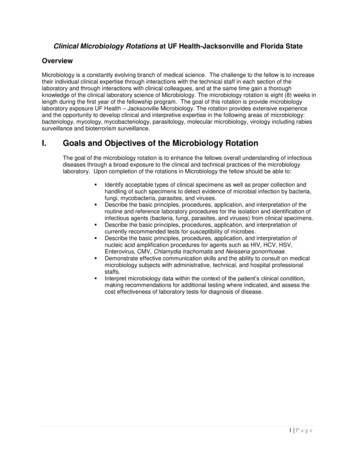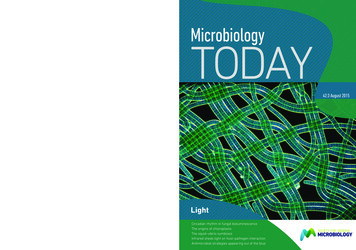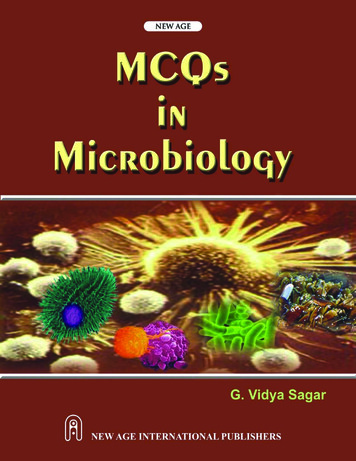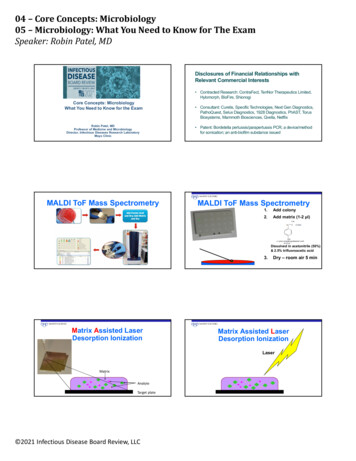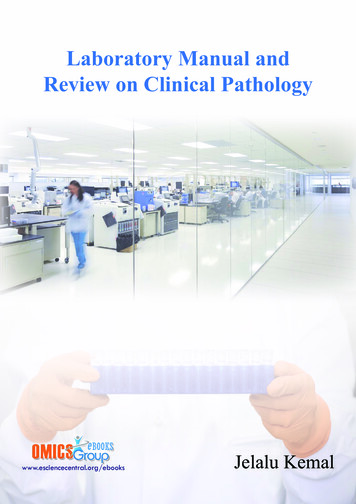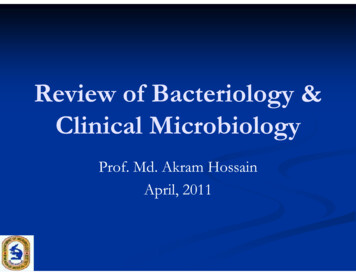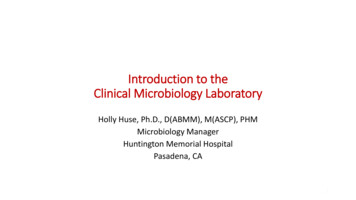
Transcription
Continue
Microbiology fundamentals a clinical approach pdf downloadDownload e-Book Book Introduction NOTE: This book will not include access card. Cowan’s Microbiology Fundamentals: A Clinical Approach is The Perfect Fit to align with your course. Here's why: The author team includes a practicing nurse to help students see how the content fits in their lives and relates to their future career on every page. Abriefer text means all core concepts are covered, but streamlined to better fit the length of your course. A more modern, visual text and digital learning package fits with today’s students and the way they learn. Users who purchase Connect Plus receive access to the full online ebook version of the textbook This site comply with DMCA digitalcopyright. We do not store files not owned by us, or without the permission of the owner. We also do not have links that lead to sites DMCA copyright infringement. If You feel that this book is belong to you and you want to unpublish it, Please Contact us . Foundations In Microbiology Alcamos Fundamentals of Microbiology Marjorie Kelly Cowan withJennifer Bunn, RN FUNDAMENTALS Second Edition Clinical Insights Tips and stories from a practicing nurse Digital Tools Focused on learning outcomes to help you achieve your goals NCLEX -Style Questions Inside & Online! New Chapter: One Health by Ronald M. Atlas The Interconnected Health of the Environment, Humans, and Other AnimalsA Clinical Approach FUNDAMENTALS A Clinical Approach SECOND EDITION Marjorie Kelly Cowan Miami University Middletown WITH Jennifer Bunn RN, Clinical Advisor Ronald M. Atlas University of Louisville Contributor Heidi Smith Front Range Community College Digital Author MICROBIOLOGY FUNDAMENTALS: A CLINICAL APPROACH,SECOND EDITION Published by McGraw-Hill Education, 2 Penn Plaza, New York, NY 10121. Copyright 2016 by McGraw-Hill Education. All rights reserved. Printed in the United States of America. Previous edition 2013. No part of this publication may be reproduced or distributed in any form or by any means, or stored in a database or retrievalsystem, without the prior written consent of McGraw-Hill Education, including, but not limited to, in any network or other electronic storage or transmission, or broadcast for distance learning. Some ancillaries, including electronic and print components, may not be available to customers outside the United States. This book is printed on acid-freepaper. 1 2 3 4 5 6 7 8 9 0 RMN/RMN 1 0 9 8 7 6 5 ISBN 978-0-07-802104-6 MHID 0-07-802104-9 Senior Vice President, Products & Markets: Kurt L. Strand Vice President, General Manager, Products & Markets: Marty Lange Vice President, Content Design & Delivery: Kimberly Meriwether David Managing Director: Michael Hackett Brand Manager:Amy Reed/Marija Magner Director, Product Development: Rose Koos Product Developer: Darlene M. Schueller Marketing Manager: Kristine Rellihan Digital Product Analyst: Jake Theobald Director, Content Design & Delivery: Linda Avenarius Program Manager: Angela R. FitzPatrick Content Project Manager: Sherry Kane Buyer: Laura M. FullerDesign: Trevor Goodman Content Licensing Specialists: John Leland/Leonard Behnke Cover Image: Colin Anderson/Blend Images LLC Janis Christie/Digital Vision/Gettyimages Universal Images Group/Gettyimages Eye of Science/Science Source Compositor: MPS Limited Printer: R. R. Donnelley All credits appearing on page or at the end ofthe book are considered to be an extension of the copyright page. Library of Congress Cataloging-in-Publication Data Cowan, M. Kelly, author. Microbiology fundamentals : a clinical approach / Marjorie Kelly Cowan, Miami University with Jennifer Bunn, RN, clinical contributor, and with contributions from Ronald M. Atlas -- Second edition. pages cmIncludes index. ISBN 978-0-07-802104-6 (alk. paper) 1. Microbiology. I. Bunn, Jennifer, RN, author. II. Atlas, Ronald M., 1946- author. III. Title. QR41.2.C692 2016 579—dc23 2014031852 The Internet addresses listed in the text were accurate at the time of publication. The inclusion of a website does not indicate an endorsement by the authors orMcGraw-Hill Education, and McGraw-Hill Education does not guarantee the accuracy of the information presented at these sites. www.mhhe.com Brief Contents CHAPTER CHAPTER 1 2 3 4 5 6 7 8 9 10 11 12 13 14 15 16 17 18 19 20 21 22 Introduction to Microbes and Their Building Blocks 2 Tools of the Laboratory: Methods for the Culturing andMicroscopic Analysis of Microorganisms 34 CHAPTER Bacteria and Archaea 60 CHAPTER Eukaryotic Cells and Microorganisms 86 CHAPTER Viral Structure and Life Cycles CHAPTER Microbial Nutrition and Growth 140 CHAPTER Microbial Metabolism CHAPTER Microbial Genetics and Genetic Engineering 192 CHAPTER Physical and ChemicalControl of Microbes 232 CHAPTER CHAPTER CHAPTER CHAPTER CHAPTER CHAPTER CHAPTER CHAPTER CHAPTER CHAPTER CHAPTER CHAPTER CHAPTER 114 166 Antimicrobial Treatment 258 Interactions Between Microbes and Humans 288 Host Defenses I: Overview and Nonspecific Defenses 322 Host Defenses II: Specific Immunity andImmunization Disorders in Immunity 348 380 Diagnosing Infections 408 Infectious Diseases Affecting the Skin and Eyes 436 Infectious Diseases Affecting the Nervous System 466 Infectious Diseases Affecting the Cardiovascular and Lymphatic Systems 498 Infectious Diseases Affecting the Respiratory Systems 532 Infectious Diseases Affecting theGastrointestinal Tract 560 Infectious Diseases Affecting the Genitourinary System 600 One Health: The Interconnected Health of the Environment, Humans, and Other Animals 632 Contributed by Ronald M. Atlas iii About the Authors Kelly Cowan, PhD, has been a microbiologist at Miami University since 1993, where she teaches microbiology for prenursing/allied health students at the university’s Middletown campus, a regional commuter campus that accepts first-time college students with a high school diploma or GED, at any age. She started life as a dental hygienist. She then went on to attain her PhD at the University of Louisville, and later worked at the University of Maryland’s Center ofMarine Biotechnology and the University of Groningen in The Netherlands. Kelly has published (with her students) 24 research articles stemming from her work on bacterial adhesion mechanisms and plant-derived antimicrobial compounds. But her first love is teaching—both doing it and studying how to do it better. She is past chair of theUndergraduate Education Committee of the American Society for Microbiology (ASM). When she is not teaching or writing, Kelly hikes, reads, and still tries to (s)mother her three grown kids. Jennifer Bunn, RN, is a registered nurse, having spent most of her career in rural medicine, where she has had the opportunity to interact with patients of allages. Her experience includes emergency medicine and critical care, pediatrics, acute care, long-term care, and labor and delivery. Currently, Jennifer works on an acute care unit. Over the span of her career, she has enjoyed mentoring and precepting LPN and RN students. Jennifer writes medical content for websites, apps, and blogs. Ronald M.Atlas is Professor of Biology at the University of Louisville. He was a postdoctoral fellow at the Jet Propulsion Laboratory where he worked on Mars Life Detection. He has served as President of the American Society for Microbiology, as cochair of the American Society for Microbiology Biodefense Committee, as a member of the DHS HomelandSecurity Science and Technology Advisory Committee, and as chair of the Board of Directors of the One Health Commission. He is author of nearly 300 manuscripts and 20 books. His research on hydrocarbon biodegradation has helped pioneer the field of petroleum bioremediation. He has performed extensive studies on oil biodegradation and hasworked for both Exxon and the U.S. EPA as a consultant on the Exxon Valdez spill and for BP on the Deepwater Horizon spill in the Gulf of Mexico. Heidi Smith leads the microbiology department at Front Range Community College, Fort Collins, Colorado. Student success is a strategic priority at FRCC and a personal passion of Heidi’s. Collaborationwith other faculty across the nation, the development and implementation of new digital learning tools, and her focus on student learning outcomes have revolutionized her face-to-face and online teaching approaches and student performance in her classes. Outside of the classroom, Heidi served as the director of the FRCC Honors Program for sixyears, working with other faculty to build the program from the ground up. She is also an active member of the American Society for Microbiology and participated as a task force member for the development of their Curriculum Guidelines for Undergraduate Microbiology Education. Off campus, Heidi spends as much time as she can enjoying thebeautiful Colorado outdoors with her husband and three young children. iv Preface book. I wrote is th y tr to u at excited for yo ry e v Students: m a ght things th ri I e . re th e n h o re s a u c u t fo g m so glad yo ks that didn’ o o b m o t overwhelmin fr o g n Welcome! I a t in u h c b a d te li o , s n da of frustratio ink, you) nee th I , at are the d h n itafter years a ( W : ts lf n e e s d y m tu s sked rked needed. My diseases. I a s u o ti c nd then I wo my students fe A in ? d w n o a n y g m lo o ars fr to microbio member 5 ye re to . introduction ts n e d the big picture nt my stu a to w d I te in ts o p p e c g n uch detail thin m ry o e s v e major co t o n re u s is g in ere m there, mak ou context, th y e iv gscribed right e to d il re backward fro ta a e d s e h s g s e u proc ok h a s e n o s. Biological le ip c than most n While this bo ri d p a r re jo a to m r e ie s th a is e lose sight of . The format m e th rgins. The a te a that you will m tr r s e lu id il w t a d n ea lustrations th y coauthor, text on a pag f M o t. n n m te n lu next to the il o o c c l e on nica thereis only tions and cli e a nd s tr u s a c lu e il b g , s n k ti o n the page a res bo o te fe in li d d to a e c to n rie m e s pa c e alth yea r s of e x pe r e h s g margins gave n rking as a he o ri b w o re h a w u e o rs y u , he n n, is a n ical Moments tter to you w d a e m M l Jennifer Bun il , s w e il n o F ti e a Ca s w this inform the-moment to p u lso be sure to dA n a s h ows you ho r. g te n p ti a s h c re very e questions in e We have inte X r success in th E u L o y C care provider. f N o d l n o a tr , n s o ke c linic selection can really ta u o y re e h Inside the C w is is d. t content—th c e n n o C ls as you nee my o e to th e th u se f o y an d using it in m te r s a ta s f o I e . s k u o e ing of bo at, but I hop classby mak if ferent kind th d y a a s e b to e to v a is yh d th ll, maybe the e I really wante W ! it e cience book. v s lo f o ts d n e in d k tu g s shin n d my t it is a refre a th own classes a elly Cowan d K n fi — d n a it y jo do e n that you truly I dedicate this book to Ted. v McGraw-Hill LearnSmart is one of the most effective and successful adaptivelearning resources available on the market today. More than 2 million students have answered more than 1.3 billion questions in LearnSmart since 2009, making it the most widely used and intelligent adaptive study tool that’s proven to strengthen memory recall, keep students in class, and boost grades. Students using LearnSmart are 13% morelikely to pass their classes, and 35% less likely to drop out. LearnSmart continuously adapts to each student’s needs by building an individual learning path so students study smarter and retain more knowledge. Turnkey reports provide valuable insight to instructors, so precious class time can be spent on higher-level concepts and discussion. Fueledby LearnSmart—the most widely used and intelligent adaptive learning resource—SmartBook is the first and only adaptive reading experience available today. Distinguishing what students know from what they don’t, and honing in on concepts they are most likely to forget, SmartBook personalizes content for each student in a continuouslyadapting reading experience. Reading is no longer a passive and linear experience, but an engaging and dynamic one where students are more likely to master and retain important concepts, coming to class better prepared. As a result of the adaptive reading experience found in SmartBook, students are more likely to retain knowledge, stay in class,and get better grades. LearnSmart Labs is an adaptive simulated lab experience that brings meaningful scientific exploration to students. Through a series of adaptive questions, LearnSmart Labs identifies a student’s knowledge gaps and provides resources to quickly and efficiently close those gaps. Once students have mastered the necessarybasic skills and concepts, they engage in a highly realistic simulated lab experience that allows for mistakes and the execution of the scientific method. LearnSmart Prep is designed to get students ready for a forthcoming course by quickly and effectively addressing prerequisite knowledge gaps that may cause problems down the road. LearnSmartPrep maintains a continuously adapting learning path individualized for each student, and tailors content to focus on what the student needs to master in order to have a successful start in the new class. vi www.learnsmartadvantage.com Digital efficacy study shows results! Digital efficacy study final analysis shows students experience higher successrates when required to use LearnSmart. Passing rates increased by an average of 11.5% across the schools and by a weighted average of 7% across all students. Retention rates increased an average of 10% across the schools and by a weighted average of 8% across all students. Study details: Included two state universities and four communitycolleges. Control sections assigned chapter assignments consisting of testbank questions and the experimental sections assigned LearnSmart, both through McGraw-Hill Connect . Both types of assignments were counted as a portion of the grade, and all other course materials and assessments were consistent. 358 students opted into theLearnSmart sections and 332 into the sections where testbank questions were assigned. “Use of technology, especially LearnSmart, assisted greatly in keeping on track and keeping up with the material.” —student, Triton College “LearnSmart has helped me to understand exactly what concepts I do not yet understand. I feel like after I complete amodule I have a deeper understanding of the material and a stronger base to then build on to apply the material to more challenging concepts.” —Student “After collecting data for five semesters, including two 8-week intensive courses, the trend was very clear: students who used LearnSmart scored higher on exams and tended to achieve a lettergrade higher than those who did not.” “This textbook was selected due to the LearnSmart online content as well as the fact that it is geared for an allied health student. This textbook has certainly enhanced the classroom experience and I see that my students are better prepared for class after they have worked within LearnSmart.” —GabrielGuzman, Triton College —Jennifer Bess, Hillsborough Community College vii Connecting Instructors to Students McGraw-Hill Connect Microbiology McGraw-Hill Connect Microbiology is a digital teaching and learning environment that saves students and instructors time while improving performance over a variety of critical outcomes. Instructors have access to a variety of resources including assignable and gradable interactive questions based on textbook images, case study activities, tutorial videos, and more. Digital images, PowerPoint lecture outlines, and instructor resources are also available through Connect. All Connect questions are tagged to a learning outcome,specific section and topic, ASM topics and curriculum guidelines, and Bloom’s level for easy tracking of assessment data. Visit www.mcgrawhillconnect.com. Connect Insight is a powerful data analytics tool that allows instructors to leverage aggregated information about their courses and students to provide a more personalized teaching andlearning experience. McGraw-Hill Campus integrates all of your digital products from McGraw-Hill Education with your school’s learning management system for quick and easy access to best-in-class content and learning tools. viii Through Innovative Digital Solutions Unique Interactive Question Types in Connect, Tagged to ASM’s CurriculumGuidelines for Undergraduate Microbiology 1 Case Study: Case studies come to life in a learning activity that is interactive, self-grading, and assessable. The integration of the cases with videos and animations adds depth to the content, and the use of integrated questions forces students to stop, think, and evaluate their understanding. Preand posttesting allow instructors and students to assess their overall comprehension of the activity. 2 Concept Maps: Concept maps allow students to manipulate terms in a hands-on manner in order to assess their understanding of chapter-wide topics. Students become actively engaged and are given immediate feedback, enhancing their understanding ofimportant concepts within each chapter. 3 What’s the Diagnosis: Specifically designed for the disease chapters of the text, this is an integrated learning experience designed to assess the student’s ability to utilize information learned in the preceding chapters to successfully culture, identify, and treat a disease-causing microbe in a simulated patientscenario. This question type is true experiential learning and allows the students to think critically through a real-life clinical situation. 4 Animations: Animation quizzes pair our high-quality animations with questions designed to probe student understanding of the illustrated concepts. 5 Tutorial Animation Learning Modules: Animations, videos,audio, and text all combine to help students understand complex processes. These tutorials take a stand-alone, static animation and turn it into an interactive learning experience for your students with real-time remediation. Key topics have an Animated Learning Module assignable through Connect. An icon in the text indicates when these learningmodules are available. 6 Labeling: Using the high-quality art from the textbook, check your students’ visual understanding as they practice interpreting figures and learning structures and relationships. 7 Classification: Ask students to organize concepts or structures into categories by placing them in the correct “bucket.” 8 Sequencing: Challengestudents to place the steps of a complex process in the correct order. 9 Composition: Fill in the blanks to practice vocabulary, and then reorder the sentences to form a logical paragraph (these exercises may qualify as “writing across the curriculum” activities!). All McGraw-Hill Connect content is tagged to Learning Outcomes for each chapter as wellas topic, section, Bloom’s Level, ASM topic, and ASM Curriculum Guidelines to assist you in customizing assignments and in reporting on your students’ performance against these points. This will enhance your ability to assess student learning in your courses by allowing you to align your learning activities to peer-reviewed standards from aninternational organization. NCLEX NCLEX Prep Questions: Sample questions are available in Connect to assign to students, and there are questions throughout the book as well. ix INSTRUCTOR RESOURCES Presentation Pr P res Tools allow you to customize your lectures. Enhanced En E nhan Lecture Presentations contain lecture outlines, art,photos, and tables, embedded where appropriate. Fully a customizable, complete, and ready to use, these presentations cus will enable you to spend less time preparing for lecture! w A Animations Over 100 animations bring key concepts to life, available for instructors and students. a Animation PPTs Animations are embedded in PowerPoint for A ulultimate ease of use! Just copy and paste into your custom slide show and you’re done! sho Tak Take ke ey your course online—easily—with one-click Digital Lecture Capture. l McGraw-Hill Tegrity is a fully automated lecture capture solution used in traditional, hybrid, “flipped classes,” and online courses to record lesson, lectures, and skills. Createwhat you’ve only imagined. Introducing McGraw-Hill Create —a self-service website that allows you to create custom course materials—print and eBooks—by drawing upon McGraw-Hill Education’s comprehensive, cross-disciplinary content. Add your own content quickly and easily. Tap into other rights-secured third-party sources as well. Then,arrange the content in a way that makes the most sense for your course. Even personalize your book with your course name and information! Choose the best format for your course: color print, black and white print, or eBook. The eBook is now even viewable on an iPad! And, when you are done you will receive a free PDF review copy in justminutes! Visit McGraw-Hill Create—www.mcgrawhillcreate.com—today and begin building your perfect book. Microbiology Fundamentals Laboratory Manual, Second Edition Steven Obenauf, Broward College Susan Finazzo, Georgia Perimeter College Written specifically for pre-nursing and allied health microbiology students, this manual featuresbrief, visual exercises with a clinical emphasis. x CLINICAL Clinical applications help students see the relevance of microbiology. Case File Each chapter begins with a case written from the perspective of a former microbiology student. CASE C A S E FILE FILE These high-interest introductions provide a specific example of how the chapter content isrelevant to real life and future health care careers. Puzzle in the Valley Working as a newly graduated radiology technologist in a rural hospital in California, I encountered a case that would prove to be a Clinical Contributor challenge for everyone involved. The patient was a male migrant farm worker in his mid-30s who This textbook features aclinical advisor, Jennifer Bunn, RN, who authored the following features, described on these pages: presented to the ER with common flulike symptoms: fever, chills, weakness, cough, muscular aches and pains, and headache. He also had a painful red rash on his lower legs. It was summertime, so influenza was unlikely. The emergency roomphysician believed that the patient likely had pneumonia, but she found the Added clinical relevance throughout rash puzzling. She asked me to obtain a chest X ray. I performed anterior- the chapter Relevant case files Medical Moment boxes NCLEX prep questions Medical Moment Medical Moment “Jen added things that were fascinatingto ME! And will enrich my own teaching. Pre-allied health students are so eager to start ‘being’ nurses, etc., they love these clinical details.” These boxes give students a more detailed clinical application of a nearby concept in the chapter. —Kelly Cowan NCLEX PREP 1. The physician has ordered that a urine culture be taken on a client. Whatpriority information should the nurse know in order to complete the collection of this specimen? a. Date and time of collection b. Method of collection c. Whether the client is NPO (to have nothing by mouth) d. Age of client Outsmarting Encapsulated Bacteria Catheter-associated infections in critically ill patients requiring central venous access areunfortunately all too common. It has been estimated that bloodstream infection, a condition called sepsis, affects 3% to 8% of patients requiring an indwelling catheter for a prolonged period of time. Sepsis increases morbidity and mortality and can increase the cost of a patient’s care by approximately 30,000. In order to colonize a catheter,microorganisms must first adhere to the surface of the tip on this medical device. Fimbriae and glycocalyces are bacterial structures most often used for this purpose. NCLEX Prep Questions Found throughout the chapter, these multiple-choice questions are application-oriented and designed to help students learn the microbiology information theywill eventually need to pass the NCLEX examination. Students will begin learning to think critically, apply information, and over time, prep themselves for the examination. cow21049 ch04 086-113.indd 86 27/11/14 10:52 AM Additional questions are available in Connect for homework and assessment. Inside the Clinic Each chapter ends with areading that emphasizes the nursing aspect of microbiology. cow21049 ch03 060-085.indd 69 Fever: To Treat or Not to Treat? Clinical Examples Throughout Clinical insights and examples are woven throughout the chapter—not just in boxed elements. 26/11/14 5:28 PM Inside the Clinic Our immune system helps to protect us from invadingmicroorganisms. One manner in which our body protects itself is by mounting a fever in response to microbes present in the body (body temperature can also rise in response to inflammation or injury). The hypothalamus, located in the brain, serves as the temperature-control center of the body. Fever occurs when the hypothalamus actually resetsitself at a higher temperature. The hypothalamus raises body temperature by shunting blood away from the skin and into the body’s core. It also raises temperature by inducing shivering, which is a result of muscle contraction and serves to increase temperature. This is why people experience chills and shivering when they have a fever. Once thenew, higher temperature is reached (warmer blood reaches the hypothalamus), the hypothalamus works to maintain this temperature. When the “thermostat” is reset once again to a lower level, the body reverses the process, shunting blood to the skin. This is why people become diaphoretic (sweaty) when a fever breaks. When microorganisms gainentrance to the body and begin to proliferate, the body responds with an onslaught of macrophages and monocytes, whose puri d i i hi i i d f xi VISUAL Visually appealing layouts and vivid art closely linked to narrative complement the way 21st-century students learn. Engaging, Accurate, and Educational Art Visually appealing The pristine waters ofthis beautiful coral reef depend on keeping microbial nutrients very low so that harmful bacteria are not able to outcompete phytoplankton or cause coral diseases. art and page layouts engage students in the content, while carefully constructed figures help them work through difficult concepts. 62 CHAPTER 3 In All Bacteria Bacteria and Archaea Inchapter 1, we described bacteria and archaea as being cells with no true nucleus. Let’s look at how bacteria and archaea are different from eukaryotes: S layer—Monolayer of protein used for protection and/or attachment. bacterial cell. Cutaway view of a typical rod-shaped bacterium, showing major structural features. Ribosomes—Tiny particlescomposed of protein and RNA that are the sites of protein synthesis. Outer membrane—Extra membrane similar to cytoplasmic membrane but also containing lipopolysaccharide. Controls flow of materials, and portions of it are toxic to mammals when released. Cytoplasm—Water-based solution filling the entire cell. Both non-eukaryotic andeukaryotic microbes are ubiquitous in the world today. Although both can cause infections diseases, treating them with drugs requires different types of approaches. In this chapter and coming chapters, you’ll discover why that is. The evolutionary history of non-eukaryotic cells extends back at least 2.9 billion years. The fact that these organismshave endured for so long in such a variety of habitats can be attributed to a cellular structure and function that are amazingly versatile and adaptable. Cell wall—A semirigid casing that provides structural support and shape for the cell. Cytoskeleton—Long fibers of proteins that encircle the cell just inside the cytoplasmic membrane and contribute tothe shape of the cell. The Structure of the Bacterial Cell In this chapter, the descriptions, except where otherwise noted, refer to bacterial cells. Although bacteria and archaea share many of the same basic structural elements, we will focus on the features of bacteria because you will encounter them more often in a clinical environment. We willanalyze the significant ways in which archaea are unique later in the chapter. The general cellular organization of a bacterial cell can be represented with this flowchart: Bacterial cell Escherichia coli Table 6.1 lists the major contents of the bacterium Escherichia coli. Som components are absorbed in a ready-to-use form, and others must be synth thecell from simple nutrients. The important features of cell compositi summarized as follows: Fimbriae—Fine, hairlike bristles extending from the cell surface that help in adhesion to other cells and surfaces. Bacterial chromosome or nucleoid—Composed of condensed DNA molecules. DNA directs all genetics and heredity of the cell and codes for allproteins. The way their DNA is packaged: Bacteria and archaea have nuclear material that is free inside the cytoplasm (i.e., they do not have a nucleus). Eukaryotes have a membrane around their DNA (making up a nucleus). Bacteria don’t wind their DNA around histones; eukaryotes do. The makeup of their cell wall: Bacteria and archaeagenerally have a wall structure that is unique compared to eukaryotes. Bacteria have sturdy walls made of a chemical called peptidoglycan. Archaeal walls are also tough and made of other chemicals, distinct from bacteria and distinct from eukaryotic cells. Their internal structures: Bacteria and archaea don’t have complex, membraneboundedorganelles in their cytoplasm (eukaryotes do). A few bacteria and archaea have internal membranes, but they don’t surround organelles. Chemical Analysis of Microbial Cytoplasm In Some Bacteria Figure 3.1 Structure of a Cell (cytoplasmic) membrane—A thin sheet of lipid and protein that surrounds the cytoplasm a
Microbiology fundamentals a clinical approach pdf download Download e-Book Book Introduction NOTE: This book will not include access card. Cowan’s Microbiology Fundamentals: A Clinical Approa
